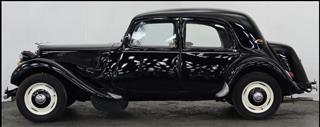Where (and why) to fit the sender probe for a temperature gauge on a Traction Avant?
Now the French and Belgium built Traction Avants came from the factory with the minimum of equipment, no oil pressure gauge, no temperature gauge so are they really required?
Well personal experience says yes they are a worthwhile addition to the car to try and prevent serious damage by spotting the danger signs early.
Running the car on the open road usually brings no coolant problems if the system is clean however if you hit traffic and are crawling along then the temperature will rise. At one stage on several occasions in crawling traffic I watched the gauge go over the 100c mark!
The oil pressure gauge pickup is usually taken from the blanking plug for the maim gallery on the engine block at the right side, near the bulkhead and is a reliable place to take it from.
For the coolant temperature the usual place (and easiest) is to fit a probe in the top radiator hose between the water pump outlet and the radiator but it has some limitations as it can sit above the coolant itself and is not 'aesthetically' pleasing on the eye as can be seen in image 1 below.....
So where else to fit it?
Well the best place would be into the water jacket on the engine block but how to do that. It's quite simple really as between the actual water pump and the cylinder head there is a cast iron 'housing' (part 451969) shown in the 2nd image above which can be drilled and tapped to accept a temperature probe or switch, depending on the type of gauge you fit.
Now the place to fit the adaptor is on the left side (looking from the front of the car) as that is the 'hot' coolant outlet to the radiator, the other side is cooled fluid from the bottom of the radiator being fed by the pump into the block and along the valve coolant tube in the cylinder head.
In this case we simply reused the adaptor from the top radiator hose.
The housing was drilled and tapped to match the probe fitting and screwed in from the inside of the housing.
Now the internal casting has a 'rough' cast finish so the adaptor needs to be 'sealed' to prevent any possible water leaks so I used an 'O' ring between the adaptor and housing along with a touch of 'instant gasket' to ensure the joint was watertight as shown in image 1 below.
OK but how do you remove the pump housing?
It's quite simple really and only requires a few tools. First drain the coolant from the engine (there is a drain plug on the left side just in front of the 'volute' spring) and remove the top hose.
Then slacken the alternator/dynamo off so slacken the water pump dive belt.
Now remove the water pump bolts, 5 X 7mm and 2 x 10mm at the bottom You need an 11mm ring and a 17mm spanner and socket. There is no need to remove the radiator or the pump fan blade as there is room to slide the unit out complete.
Once the pump is out there are 2 further recessed bolts holding the pump adaptor to the cylinder head. Now the original Citroen bolts have a slightly smaller head which requires a 16mm socket. If they have been replaced in the past you may need a thin walled 17mm socket, but you won't know until the pump is removed.....
Once the pump adaptor is off the car and you have cleaned it up and fitted your 'probe adaptor'/switch then it's simply a case of refitting everything in reverse order (using new gaskets of course) and connecting up your coolant temperature gauge.
Last revision: 11th June 2018

